Trees: Bridges Between Past, Present, and Future
We generally don’t pay much attention to trees as we go about our lives. Unless you’re looking for shade on a hot day, trees are simply there–a part of our environment no more remarkable than clouds in the sky or grass on the ground. But the power and strength symbolized by these silent sentinels have grown deep roots into our collective psyche.
Trees are not just silent observers of our lives; they are companions that hold within them the threads of our past, present, and even the possibilities of our future. These majestic beings stand tall and proud, witnessing the unfolding of human history and personal journeys. Many of us have felt a connection to a special tree, which I call an emotional tree, that serves as a point of contact with our memories, stories, and aspirations. To me, these trees are more than just plants; they are living archives of our lives, retaining the essence of our experiences.
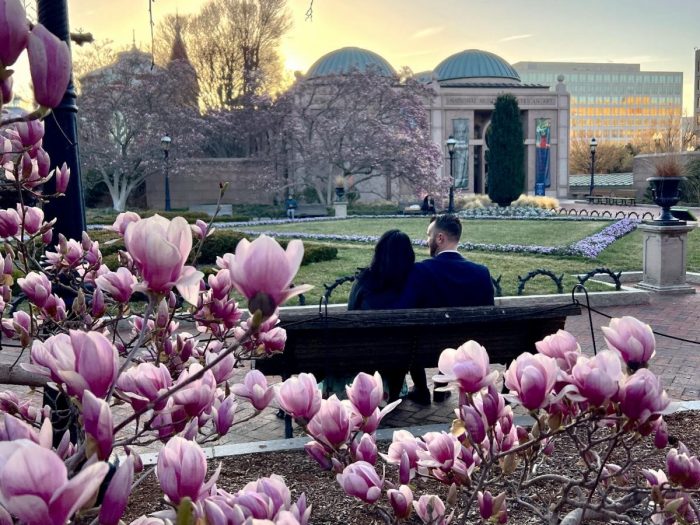
A couple enjoys the sunset serenity of the Enid A. Haupt Garden. A tulip magnolia blooms in the foreground. (Photo courtesy Smithsonian Gardens)
Emotional Trees: Connecting with Nostalgia
Can you think of a tree that stirs up emotions and nostalgia, a tree that feels like an old friend? It might be from your childhood, one that grew alongside you, or perhaps a tree that your family planted with care. For me, it’s the mango tree in my neighborhood. It’s the tree my friends and I used to climb, starting from the lowest branches and gradually making our way to the top. Those moments spent in its branches hold a treasure trove of memories and laughter. Each climb was an adventure, a test of bravery and friendship, as we navigated its sturdy limbs and enjoyed the thrill of reaching the summit.
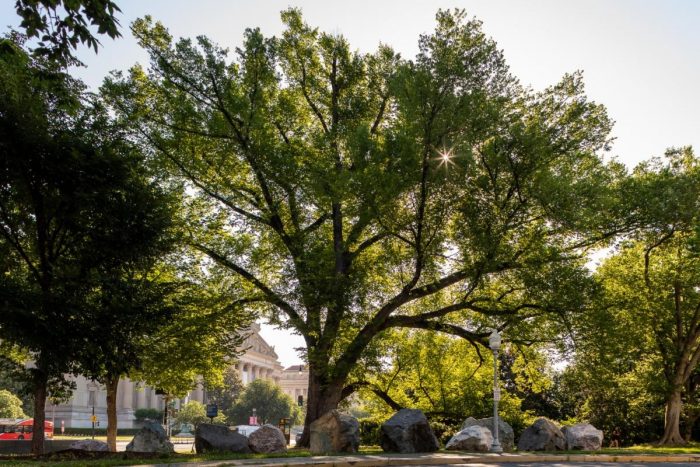
A majestic American Elm continues to thrive on the National Mall. (Photo courtesy Smithsonian Gardens)
These emotional trees often serve as the setting for moments of introspection, where we find solace and peace, whether it’s reading a book under their shade or simply enjoying the rustle of their leaves. Parks filled with these trees become sanctuaries for our mental well-being, offering us a space to unwind and reconnect with ourselves. The rustling leaves create a symphony of nature, a soothing backdrop to our thoughts and reflections. These trees provide a natural escape, a place where we can leave behind the stresses of daily life and find a moment of tranquility.
Trees as Vessels of Imagination
Beyond their role in our memories, trees also act as gateways to different possibilities. They inspire us to envision a world where sustainability and harmony with nature are at the forefront. Through these living beings, we can paint a picture of a future where our connection with the environment is profound and respectful. Trees encourage us to dream big, to imagine forests teeming with life and cities where green spaces are abundant. They remind us of the possibilities that come with nurturing our planet and the beauty that can be achieved through mindful coexistence.
Cultural Significance of Trees
Throughout history, cultures around the world have revered trees for their symbolic meaning and identity. They are not just physical entities but carriers of stories, traditions, and wisdom. Trees have been depicted in myths and legends, serving as symbols of life, growth, and interconnectedness. They stand as silent witnesses to the evolution of civilizations and the perpetuation of cultural narratives.

Artist’s rendering of a Banyan tree. Image courtesy freepik.com (https://img.freepik.com)
In many cultures, trees are considered sacred and often associated with deities or spiritual beings. For instance, the Bodhi tree under which Siddhartha Gautama attained enlightenment is a revered symbol in Buddhism, representing wisdom and spiritual awakening. Similarly, in Hinduism, the Banyan tree is seen as a symbol of immortality and often connected with the god Vishnu.
The Norse mythological tree, Yggdrasil, is another profound example. This immense ash tree connects the nine worlds of Norse cosmology, symbolizing the universe and the interconnectedness of all life. Yggdrasil is seen as the axis mundi, or the world’s axis, serving as a bridge between the heavens, earth, and the underworld.
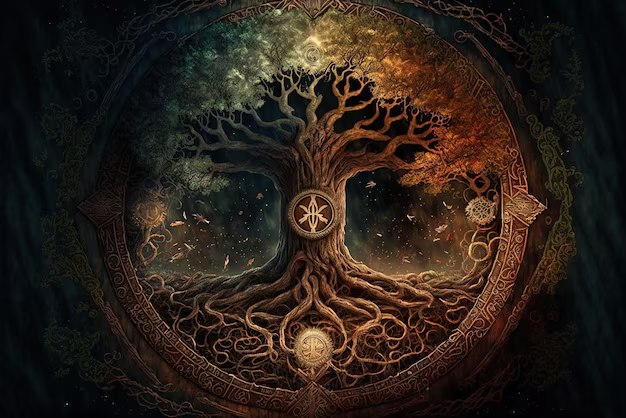
Artist’s rendering of Yggdrasil, the Tree of Life in Norse mythology. Image courtesy of https://img.freepik.com/
In Celtic traditions, trees were believed to be the ancestors of humans, and each tree species was thought to possess its own unique spirit and power. The Druids, the priestly class among the Celts, held trees in high regard and often conducted their rituals in sacred groves. The Oak tree, in particular, was venerated for its strength and longevity and considered a gateway to the divine.
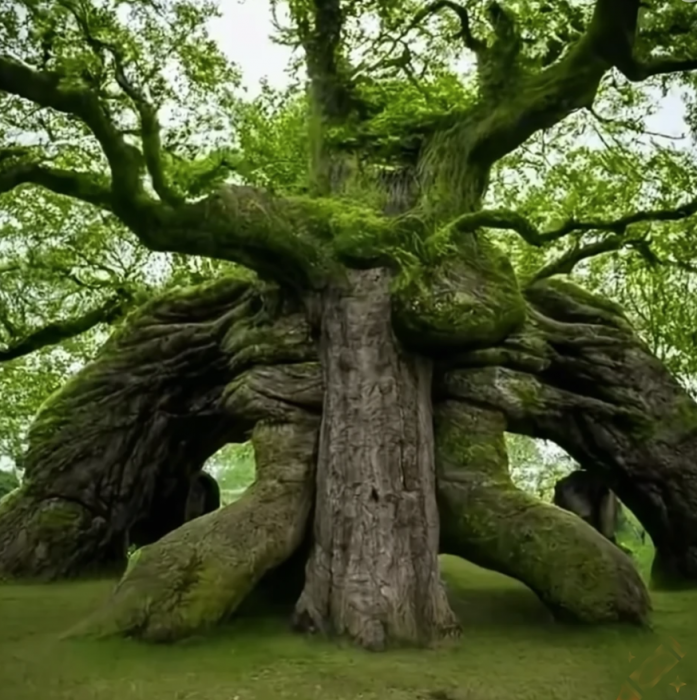
Ancient oak tree adorned with Celtic symbols. (Image courtesy craiyon.com)
In a number of different African cultures, the Baobab tree is often referred to as the “Tree of Life,” providing food, water, and shelter to both humans and animals in the arid regions where it grows. Its hollow trunk is even used sometimes as a place of worship. The Baobab’s resilience and ability to thrive in harsh conditions make it a powerful symbol of endurance and survival.
In Japan, the Cherry Blossom (Sakura) holds significant cultural meaning. The ephemeral beauty of the cherry blossoms, which bloom for a very short period each spring, is a reminder of the transient nature of life. Hanami, or flower viewing, is a traditional practice where people gather to appreciate the fleeting beauty of the blossoms, reflecting on the impermanence of life and the importance of living in the moment.
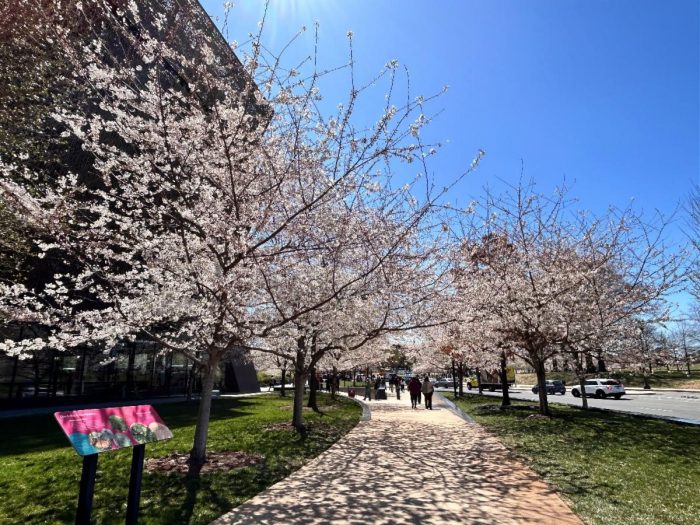
Cherry trees line the sidewalk in front of the National Museum of African American History and Culture. (Image courtesy Smithsonian Gardens)
In modern times, trees continue to hold immense cultural significance and are often used as powerful symbols in literature, art, and environmental movements. They are emblematic of growth, renewal, and the interconnectedness of all life on earth. The tree of life motif, which has been depicted throughout history in numerous ways across different cultures, encapsulates the essence of trees as universal symbols of life, continuity, and the intricate web of existence. This motif is often illustrated in religious texts, mythologies, and artistic representations, serving as a reminder of the enduring relationship between nature and humanity. Trees not only represent the cycle of life and rebirth but also stand as a testament to the resilience and strength found in natural ecosystems. Their presence in cultural narratives underscores the importance of preserving and protecting these vital organisms for future generations.
Smithsonian Gardens: Preserving Nature in Urban Landscapes
In the heart of the bustling cityscape of Washington, D.C., lies Smithsonian Gardens, a sanctuary of greenery and tranquility. The tree collection it maintains serves a dual purpose: to provide a refuge for those seeking nature’s embrace in an urban setting and to offer a glimpse into the diverse botanical world. These gardens and landscapes demonstrate a harmonious coexistence of urban development and the preservation of nature. They showcase the importance of integrating green spaces into city planning, ensuring that even in the midst of concrete and steel, nature finds a place to thrive.

A wetland garden is a key feature of the landscaping at the National Museum of the American Indian (Photo courtesy Smithsonian Gardens)
Amidst streets, sidewalks, and high-rises, these gardens stand as a testament to the importance of preserving green spaces for the well-being of both the environment and its inhabitants. They beckon visitors to immerse themselves in the beauty of nature, fostering a sense of belonging and connection that is essential for a harmonious existence. The gardens are a living classroom, educating visitors about the significance of biodiversity and the need for conservation efforts. They inspire a deeper appreciation for the natural world and the many roles trees play in maintaining ecological balance.

An Eastern Redbud announces the arrival of spring. (Photo courtesy Smithsonian Gardens)
Trees are not just biological entities but are deeply embedded in the cultural and spiritual fabric of societies across the world. They link us to our past, ground us in the present moment, and inspire us to dream of a better future. Trees offer us shade, shelter, and sustenance, enriching our lives in countless ways. So next time you pass by a tree that speaks to your soul, take a moment to listen to its whispers of history and hope. Embrace the connection, for within its branches lies a world of wisdom waiting to be discovered.
This is a lightly edited version of a piece contributed by Gustavo Nascimento, Smithsonian Gardens Leadership for Change Summer 2024 intern, to the Smithsonian Gardens April 2025 newsletter.
Posted: 20 May 2025
-
Categories:
Education, Access & Outreach , Feature Stories , Science and Nature



